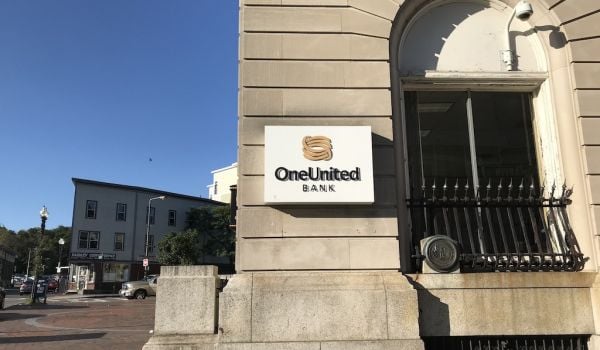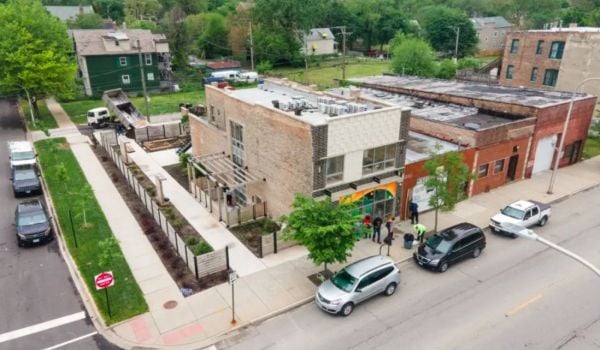Jordan Miller never thought it was in the cards for him to help start a new bank. Over the course of a 40-year career in banking, he witnessed the number of banks across the country dwindle from more than 14,000 to around 5,000 by the time he retired in 2019.
But after coming out of retirement to co-found the country’s first new Black bank since 2003, the Adelphi Bank co-founder and CEO is really just picking up almost exactly where his predecessors – brothers in his Black fraternity, as it turns out – had left off on the near-east side of Columbus, Ohio.
“We got the name Adelphi Bank from a Black-owned bank that was here in the 1920s, Adelphi Building Savings & Loan Company,” Miller says. “Three of my fraternity brothers owned it and they owned the building.”
That building went up at 818 East Long Street in 1921. It was during what banking historian and author Mehrsa Baradaran called “the golden age of Black banking.” As millions of Black Americans left the south during the Great Migration and settled in other parts of the country, racist zoning and real estate practices consistently steered most of them into segregated neighborhoods like this one, named Bronzeville after the more famous one in Chicago. For a while, the steady influx of new residents into these neighborhoods proved a boon for local businesses, including banks. Between 1900 and 1934, around 130 Black banks and 50 Black credit unions formed in cities across the country.
The original Adelphi anchored a thriving Black commercial corridor in Bronzeville. A couple blocks down on Long Street, a Black developer built the Lincoln Theater in 1928, serving Black patrons who were either forbidden entry to or relegated to the balcony sections of the Ohio capital city’s downtown theaters.
There are multiple reasons why the neighborhood eventually declined, but like many of these once-thriving Black neighborhoods in cities across the country, one of the biggest reasons was racist local officials deciding to ram a federally-funded highway through it.
“When I was a kid I lived near here, we went to the movie theater,” Miller says. “When they built the I-71 freeway right through the neighborhood, it killed a lot of businesses.”
The Lincoln Theater barely survived, closing in 1974, and gradually falling into disrepair before the city finally took it over, restoring and reopening it in 2009. The original Adelphi building became a funeral home for many years, but had already been shuttered by the time it was demolished in 2019 to clear the way for a $20 million mixed-use development. The new development incorporates the facade from the original Adelphi building and features the newly chartered Adelphi Bank as its anchor commercial tenant.
Over the past year or so, Miller and his co-founders raised nearly $25 million in startup capital for the bank, from approximately 75 different investors — around 90% of them from around central Ohio, according to Miller. Adelphi Bank received final approval from state and federal regulators on Jan. 18.
“We looked at all the options from fintechs, to neo-banks, to credit unions and even community development financial institutions,” says Kevin Boyce, co-founder and vice chair of the board. “We zeroed in on the banking platform because we felt [we should] build that as the base and we could branch out and do all of those other things as we grow.”
The U.S. banking system has long relied on groups of local investors, often local business or civic leaders including church groups, to pool their wealth and invest in new community banks. The thinking is that local investors have the knowledge and relationships to run a community bank. They understand local markets, can judge whether a business or real estate project has a reasonable chance of success, and ultimately have “skin in the game” — since they put their own wealth at risk by investing in the bank, they have a strong incentive to make sure the bank is successful.
By relying so much on local investors to start new community banks, the whole system is inherently set up to serve some communities better than others. When the Emancipation Proclamation was signed in 1863, Black households held less than 1% of wealth in the United States, a number that has barely budged since then. With relatively less wealth among Black communities to invest in new community banks, by the end of Black banking’s golden age, in 1934, Black banks still only made up less than 1% of all 14,000 banks across the country at the time.
To put that disparity in perspective, from 1934 to the mid-1980s, the number of banks across the country hovered between 13,000 and 15,000 – nearly all of which were community banks. But over those decades, those thousands of community banks invested in white communities while discriminating against Black communities. Even today, there are still more than 4,300 community banks across the country, but there are only 20 Black banks.
While segregation is no longer the law or an explicit policy for banks, research still shows that minority banks are more likely to serve more diverse communities and typically reach customers that have lower incomes or face constraints accessing credit at other banks.
“These minority banks are punching well above their weight in terms of the larger share of their portfolio of mortgages and small business loans going to communities that, historically, your mainstream financial institutions aren’t serving,” says Nicole Elam, CEO of the National Bankers Association, the main national trade association for minority banks.
For those Black banks that have gotten up and running, lack of access to shareholder capital also makes it harder for them to survive an economic downturn. “When you think about Black versus white banks, during the Great Recession, the closure rate was two-and-a-half times more for Black banks,” Elam says. “Under-capitalization leads to higher closures.”
Surviving remnants like the facade of the original Adelphi Building Loan & Savings stand as a reminder that Black business and civic leaders have long held an interest in investing what wealth they had back into their communities. But the wealth they had by themselves has never been enough to make up for the gap that started with slavery and continued through Jim Crow, segregation and mass incarceration.
All of the Adelphi Bank founding board members — seven out of nine of whom are Black — invested some of their own personal wealth as startup capital for the bank, and they found a few other startup investors from Black communities in Columbus. But they went outside Black communities to raise the rest of the $24 million they raised in startup capital.
“We received tremendous support from the African American community and the at-large community,” Miller says. “They know Columbus can’t be a great community without a more inclusive economy.”
The founders started out with a rolodex of around 250 contacts drawn from their previous social and business networks, from Miller’s 40-year career in mainstream commercial banking to Boyce’s decorated career as a local elected official, former Ohio state treasurer and investment banker. Some contacts had their own personal wealth to invest; some had access to institutional investment dollars that might otherwise be invested in stocks, bonds, real estate or private equity; some potentially had access to both.
The minimum investment was $50,000, and the opportunity was restricted to institutions or people considered “accredited investors” — that’s the U.S. Securities and Exchange Commission’s term for somebody with a net worth of at least $1 million or income of at least $200,000 for the previous two years.
“We didn’t want small investors who could be at risk of losing all their life savings in a single investment,” Miller says. “We were very clear as we went out, [as with any startup investment] it’s a high risk venture, no doubt about it.”
Despite the high risk, the potential rewards are hardly exorbitant, and it will take time to see any financial returns. Regulations don’t allow the bank to pay dividends to shareholders for its first three years. Investing in a new community bank, especially one serving a historically marginalized community, isn’t really for investors who are shopping around for the highest, quickest bang for their buck.
“Some people wanted us to have higher numbers and I said to them, that’s like buying a Cadillac and asking how much gas per mile it gets,” Miller says. “If that’s your question, you’re probably not a good investor for us. That’s not who we are, that’s not what this is. You’re either trusting that we can do this mission, or you don’t – and if you don’t, then don’t invest. And I told that to a lot of people.”
Most people they talked to didn’t invest. In the end, out of the hundreds of people they contacted over the past year, just 25 institutions and around 50 individuals ended up investing.
With $24 million in shares scattered across 75 shareholders, most of whom are not Black, Adelphi Bank isn’t technically a Black-owned bank. Instead it is meeting the Federal Deposit Insurance Corporation’s designation as a minority-depository institution based on the majority of its board and its target market being African American. Also, the founders say most of the shares sold to large institutional shares were non-voting shares, so that the founding board retains effective control over the bank.
That $24 million may not sound like much, but it means something much more under banking regulations. As the bank’s starting shareholder capital, that $24 million is part of what banks call “tier 1 equity.” It’s one of the most important numbers for any bank, because it sets the limits on what banks can do. Regulators require banks to have around $1 in tier 1 equity for every $11 in assets on their balance sheets. In short, $24 million means the bank can accept up to around $260 million in deposits.
That’s also the amount its portfolio can hold in loans and other investments. Adelphi Bank plans to have a diverse loan portfolio including small business loans for both new and existing businesses, commercial real estate loans, home mortgage loans and credit cards. Given that Adelphi Bank is planning to serve a target market that has been historically deprived of collateral, Miller believes the bank can emphasize cash flows over collateral in its underwriting. If Adelphi Bank eventually establishes an affiliated community development financial institution, or CDFI, it can learn from others with the same model like City First Broadway, Harbor Bank of Maryland or Southern Bancorp — all fully-chartered, Black-led banks that have an affiliated CDFI.
Boyce, who is currently a Franklin County Commissioner, never thought about starting a bank, either — until he and several other elected officials got pepper sprayed by police in May 2020, during a protest calling for change after the murder of George Floyd. Later that night, he reflected on the progress that has and hasn’t occurred since the end of slavery, the end of legal segregation and after the civil rights era.
The area that has seen the least progress, he realized, has been the creation of wealth for Black Americans. That night, for the first time, he Googled “how to start a bank.”
“The tragedy of [Floyd’s] murder is something that we have to address in society,” Boyce says. “But moreover, the even deeper tragedy would be if we didn’t change the way we go about doing life every day, and this is a change in one aspect of life that is rooted in his death.”
This story has been updated to correct the amount of startup capital that Adelphi Bank raised and add infornation about the financial institution’s shares.

Oscar is Next City's senior economic justice correspondent. He previously served as Next City’s editor from 2018-2019, and was a Next City Equitable Cities Fellow from 2015-2016. Since 2011, Oscar has covered community development finance, community banking, impact investing, economic development, housing and more for media outlets such as Shelterforce, B Magazine, Impact Alpha and Fast Company.
Follow Oscar .(JavaScript must be enabled to view this email address)
















